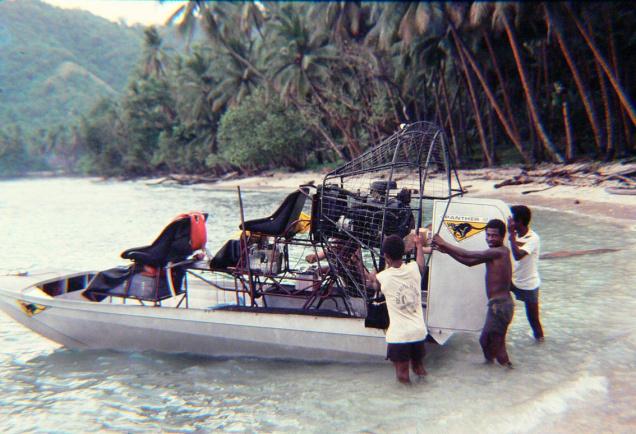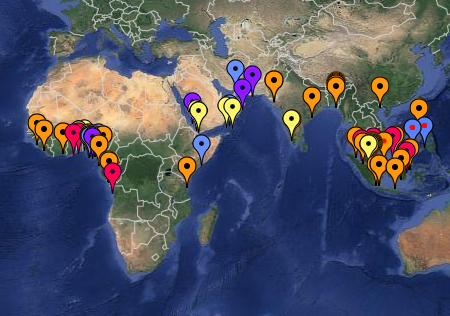Airboat adventure in Papua New Guinea
by: Janaki Lenin
posted: 15 June 2012
How to look for crocodile nests in swamps where no boat can penetrate? Salvinia, the waterweed from South America, choked all channels of the River Sepik, Papua New Guinea. The matted vegetation was so thick that it was impossible to use boats. Alistair Graham, Rom’s colleague on the croc project, came up with an idea: airboat.
Old-timers in Florida will tell you, “All an airboat needs is a bit of dew to slide over land.” It was perfect for the work on hand. Weeks later, an airboat arrived at Madang on the northern coast of the country. Alistair and Rom had to deliver it to Ambunti, a tiny village on the Sepik. That meant a two-day ride of over a 100 kilometres in the sea. But airboats are meant for swamp use, not open, choppy waters. There was no other way of transporting it except by driving it along the coast.
One early morning, the two set off with smoking Manam volcano on one side and the coast on the other. People tumbled out of coastal towns and villages, and lined the shore to see this strange beast. The airplane engine created a huge racket, while a spectacular water plume arched out of the rear end. Although none of the villagers had seen an airboat before, they promptly named it “balus boat” (“airplane boat” in English) in inimitable Pidgin, the country’s lingua franca.
Moments later, the wind direction changed and blew the water plume into the boat, swamping it. So while one of the two adventurers sat regally and drove the airboat, the other was stooped over, feverishly pumping out water with a little fuel hand pump, and feeling sick from the exhaust fumes. It was no ride in a pond. The faster they went, the more water swamped the boat. They took turns at the pump, but still it was a slow chug. Sailfish flashed their sails in threat at this strange beast on the water.
That evening, at dusk, they saw a light in a beautiful cove, and a crowd of people waving at them. It seemed as good a place as any to spend the night. The spectators were from a copra plantation run by an Australian who invited them for a beer and steak dinner, and even gave them a room for the night.
It took them all of the next day to reach the mouth of the Sepik. At the estuary, the boat was surrounded by a hundred sea snakes. Since the river was like glass, Alistair opened up the throttle and planed across the water.
Within seconds, they hit a mud bank and almost flipped over. Thick mangroves, numerous saltwater crocodiles, no help for miles in the event of an accident. It could have been a disaster. Shaken, they drove upriver, carefully avoiding solid mud banks but effortlessly gliding over logs, debris, and salvinia.
Three days after setting off from Madang and more than 200 kilometres later, they arrived in Ambunti. For the next two years, the airboat would be used to survey one of the remotest parts of the world for crocodile nests, where no man had tread or boated in a long time.
Twenty years later, Rom and I visited Ambunti. After a couple of days and nights of going up and down the river looking for crocs, one taciturn young man asked Rom quietly, “Were you the one who brought the balus boat?” A surprised Rom answered, “Yes! But how do you know? You must have been very young then.” Others, young and old, also piped up. After narrating the story, Rom concluded, “It’s one of the craziest *bleep*ing things I’ve done in my life.”
In Papua New Guinea, stories are carved on panels of wood called “storyboards” in the art market. Since I can’t carve, here is the word-story of the balus boat that conquered salvinia on the Sepik.



